Having played 29 games Wolverhampton Wanderers are currently sixth in the Premier League. Nuno Espírito Santo team are two points behind Manchester United in fifth and five behind Chelsea who are in fourth. They have only lost two Premier League games in 2020 and are in a strong position in the last 16 of the Europa League. This sort of form could be what the side needs to push for a potential Champions League spot if the season continues.
It is a credit to Nuno that since he was appointed that his side has gone from strength to strength. This season has been no different as his side has pulled off impressive results like a double over Manchester City and a win away at Tottenham Hotspur. This tactical analysis will explore Nuno’s tactics. This analysis will particularly look at how Wolves are a difficult side to beat as the side have only lost 6 times all year only Liverpool have lost less. it will analyse how they switch between a 3-5-2 and 3-4-3 to break down their opponents. Wolves have had 13 draws this season and the analysis will also explore why this has happened.
How Wolves lineup
Nuno likes to have a rotation in the squad often meaning that they switch between a 3-5-2 and a 3-4-3. What both formations do is transition to a five at the back when defending. The 3-5-2 will be used when teams like to attack centrally. This is because it enables 3 midfielders to sit in front of the defence limiting the space to play in the middle. Then when attacking they have players who will operate in between the opponent’s defensive lines. Using the example from their 0-0 draw with Brighton Hove Albion, Leander Dendoncker and João Moutinho would push forward while Rúben Neves would provide the central pivot.
The 3-4-3 would then be used when teams like to attack down the sides. This is because the two wingers provide extra support for wing-backs. It then means Wolves can break as a three. This is how they lined up in their 3-2 victory away to Spurs. Neves and Moutinho roles stay the same but now they have two players attacking either side as the wing-backs are encouraged to get forward.
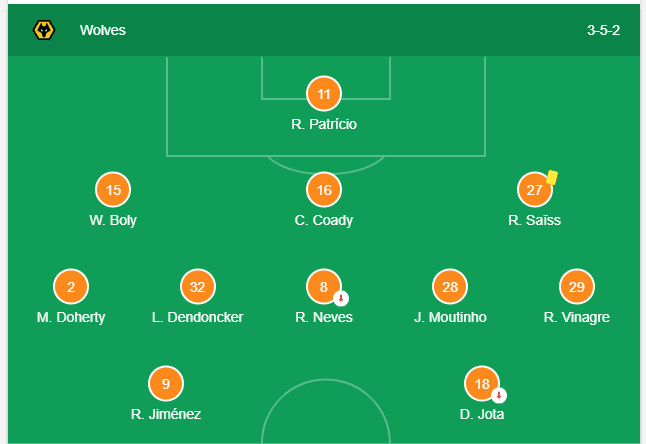
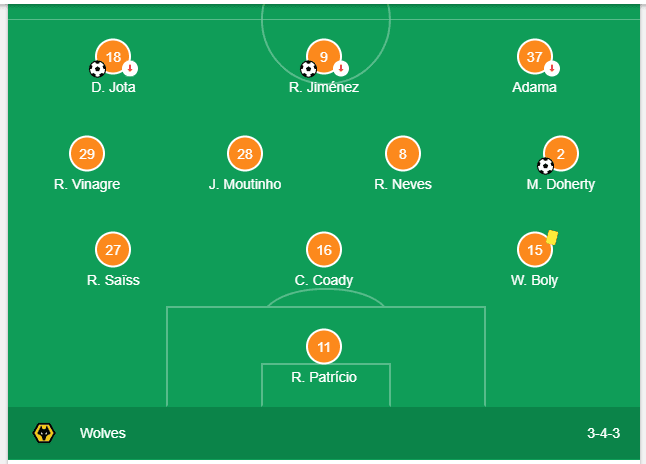
How Wolves defend
When defending with a 3-5-2 Wolves do so in three sections of the pitch. This is so it makes it difficult for teams to play through them. The first phase is in the middle of the pitch. The first phase of defending happens when the opponents are looking to build an attack. What will happen is that the front two will maintain a high position but stay central, this is to put pressure on the centre-backs if they are playing a high line or to apply pressure on a defensive midfielder. The two forwards will move across if the ball is played out wide but they will move into a position that forces the ball down the line or back. This is because Wolves are trying to stop their opponents from playing through the middle.
As the front two are remaining in an advanced position, the midfielders will also maintain a high position. The three central midfielders will remain in the middle and the wing-backs will get tight to the opponent’s wide players. The central midfielder’s role is at this point to be in a good position for the second stage of defending. However if one of the opposing players comes short to pick up the ball the closest midfielder will apply pressure. In the example below this is Dendoncker job. As both Neves and Moutinho are covering central positions it forces Aaron Mooy to switch the ball out wide. Wolves are effective at this as they win 43.98% of their offensive duels, whereas their opponents only win 38.85% of their offensive duels against Wolves.
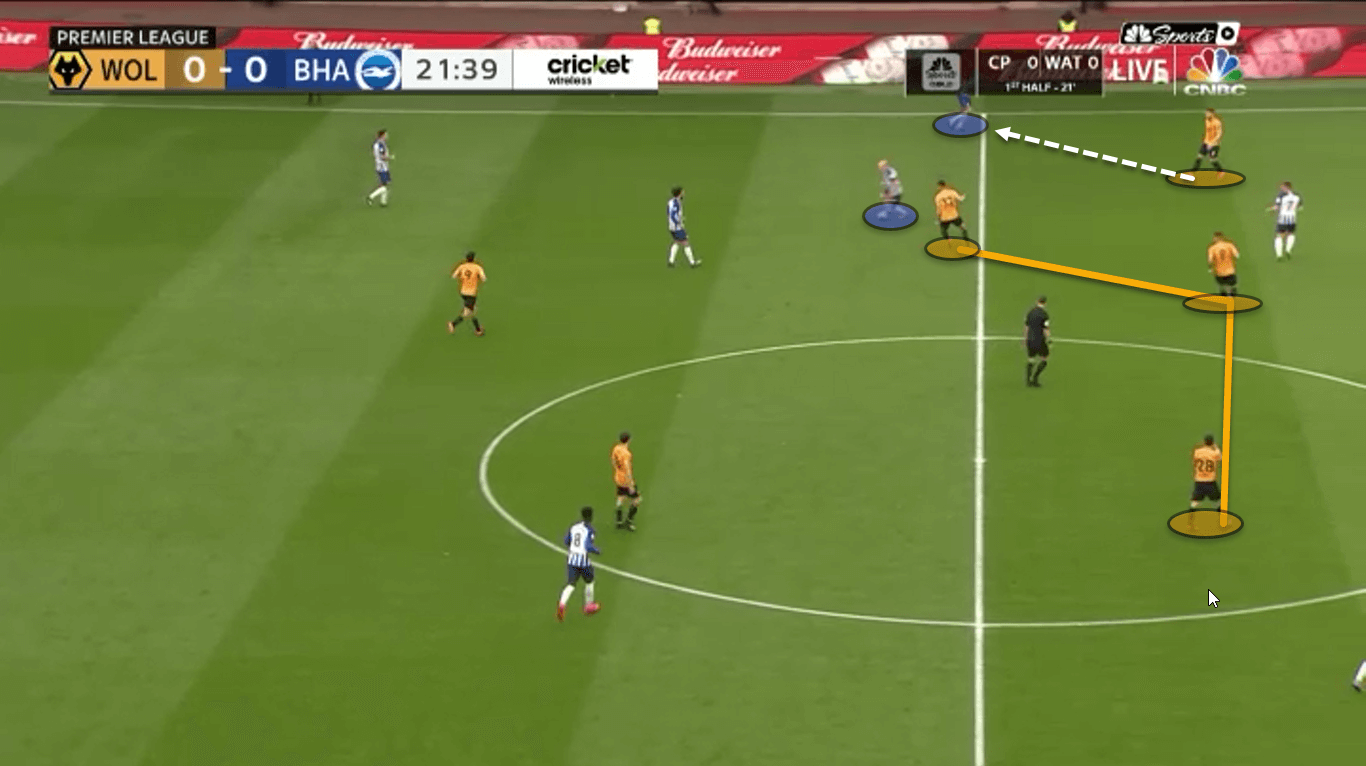
Once the ball has been played out wide it then enables Wolves to surround the ball with three players. This can happen as the wing-back will push up onto the wide player. At the same time, either a midfielder or striker will move into a position to cut down the angle on a pass back while a midfielder will be in a position to stop the ball from moving inside. In the example below, it highlights how Wolves have set up this three-man press as Raúl Jiménez narrows the angle backwards, at the same time Diogo Jota is closing down the ball with his positioning meaning he is preventing the pass inside to Yves Bissouma. This three-man press is successful as it rushes Davy Pröpper into a decision enabling Dendoncker to win the ball back. Because of the way they are set up to force the opposition wide it means that Wolves can quickly set up these three-man press often forcing players into a mistake enabling them to win the ball back, they will try to do this as much as possible and as high up the pitch as possible. They can do this with wing-backs as they do not sit as deep as a full-back.
Even if they do get out of the press there is often a player centrally, in this example it is Moutinho. This means that the attacking team will have to go back and build their attack again.
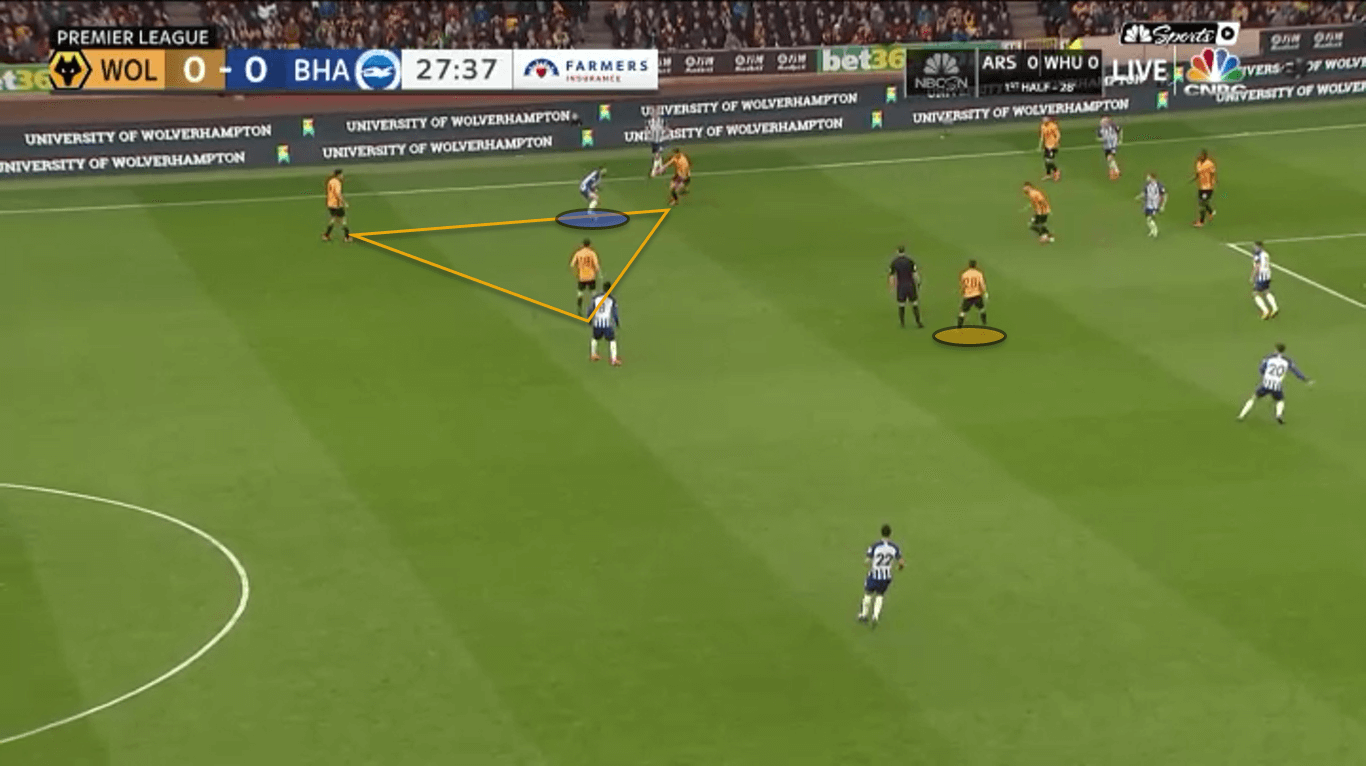
Nevertheless, if the attacking team has got the ball to the final third then the 3-5-2 will transition to a flat 5-3-2. This makes Nuno’s team compact and with the three central defenders, it means that there is little space to play through. However, Wolves will still look to use a three-man press to win the ball back.
The example shows that Max Aarons has pushed up into an advanced position, as a result in order to support Jonny; Romain Saïss has to push out wide. While Moutinho covers the centre. Saïss can leave his position as Matt Doherty will tuck in so Wolves still have four players in the box. This particular example highlights both the strength and weakness of defending this way, as Moutinho is not tight enough to Todd Cantwell, enabling him to play a one-two with Aarons. This illustrates that unless all three players press effectively teams can get around them. However, because of the defenders positioning in the box Wolves are able to stop the cross.
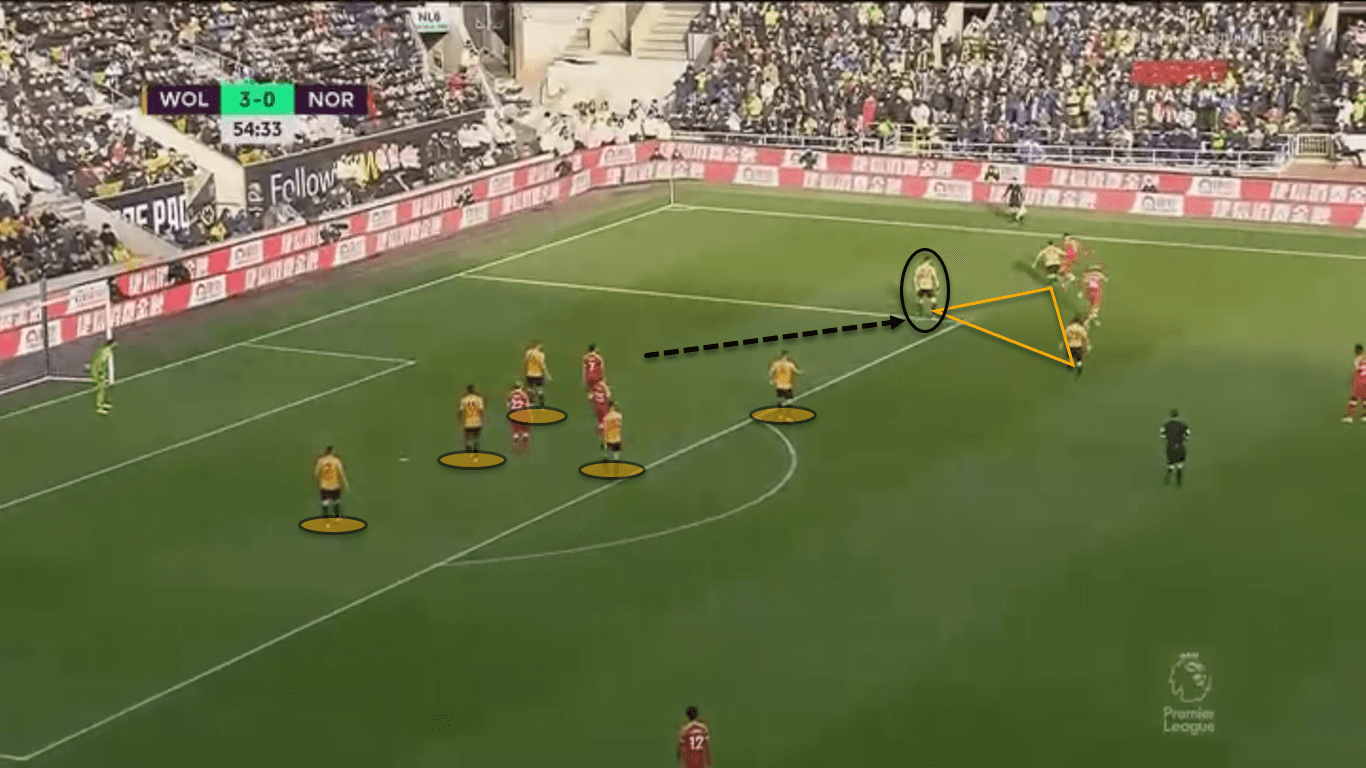
How the 3-4-3 compares
When Wolves set up in a 3-4-3 it does slightly change the way they defend. What this system can mean for Wolves is that they sit a little deeper and the formation transitions to a 5-4-1. This means that Wolves set up with two defensive lines. Wolves will often use this formation against teams that like to play out wide and push their full-backs high. Using the example from their 3-2 win over Spurs it shows how they transition to a 5-4-1. Notice how at this stage Wolves are not compact but the players are positioned so that when the ball goes out wide they can quickly apply pressure. As the ball moves through the thirds so will the formation and in the final third the 5-4-1 becomes compact.
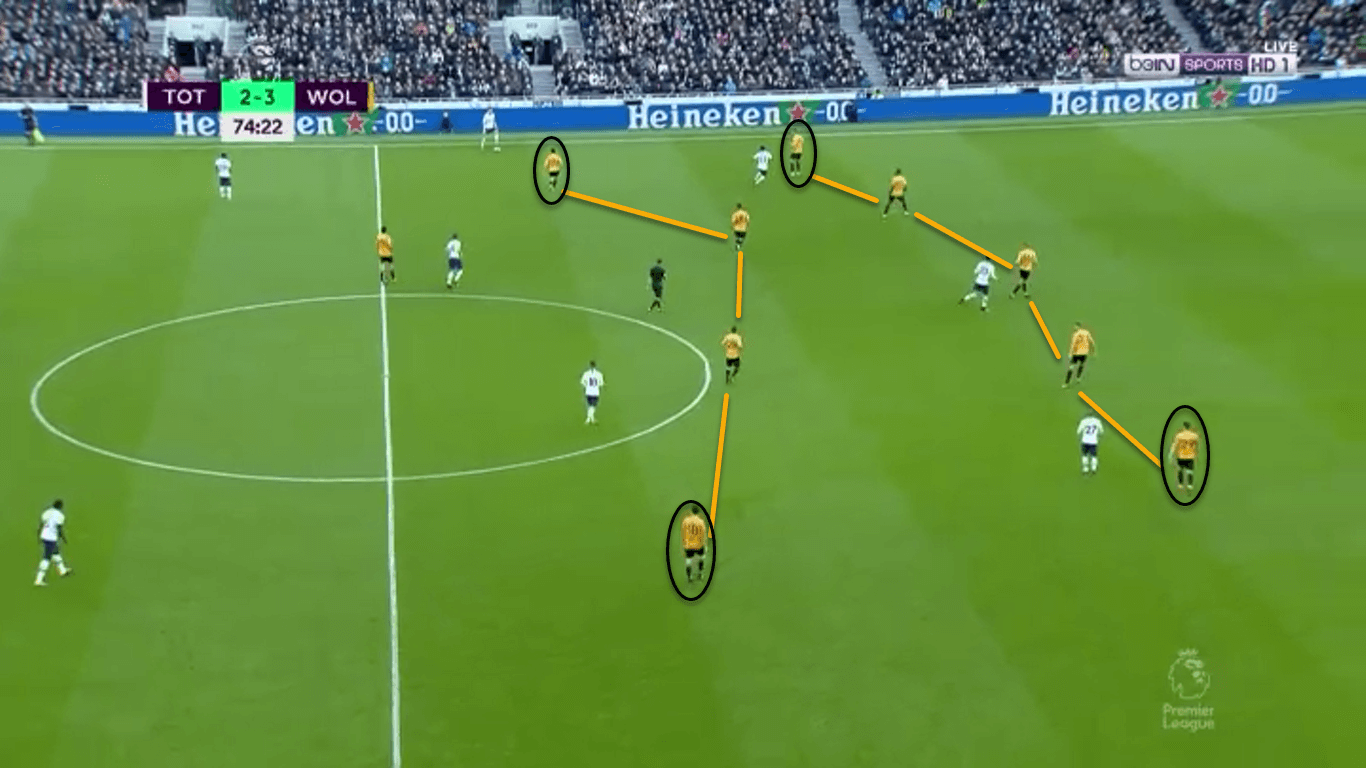
Looking at the same move it illustrates that as soon as the ball goes out to the full-back Pedro Neto moves out wide, at the same time Doherty will push up to stop the ball down the line. Willy Boly will then cover the run if the ball does get through. In this example, Wolves cut the pass out. Wolves will try and apply a three-man press when they can but with this formation, they are also able to make it difficult for teams to get down the flanks.
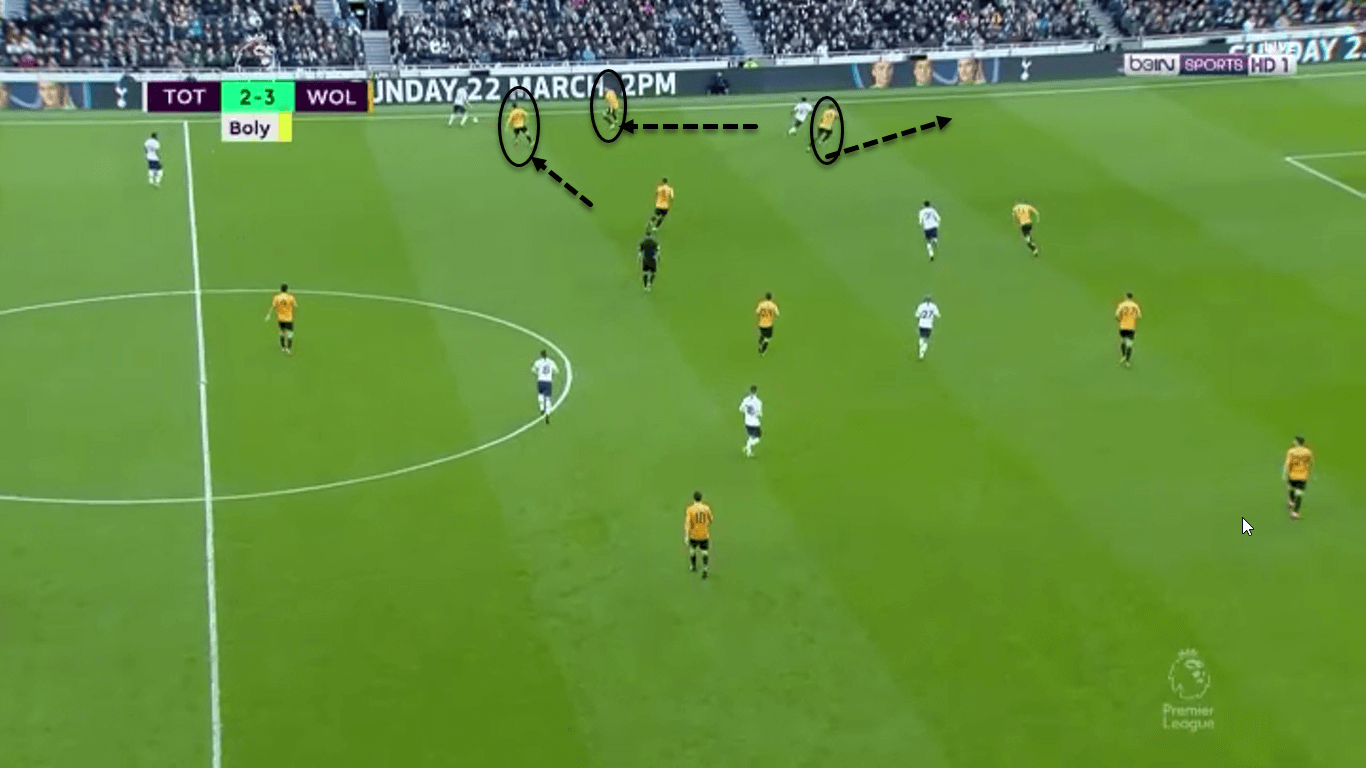
The problem Wolves sometimes have with formation is it requires the winger to get back quickly if the ball gets turned over. As the wingers will break forward and be in a more advanced position than the midfield in a 3-5-2 it can mean that the wing-back gets caught in a one-v one situation. Using the example below as Adama Traoré is slow to get back it leaves Doherty one on one with Serge Aurier. On this occasion, Aurier hesitates on the ball allowing Moutinho to get across to cover and defend the situation. However, it highlights the risk to Wolves.
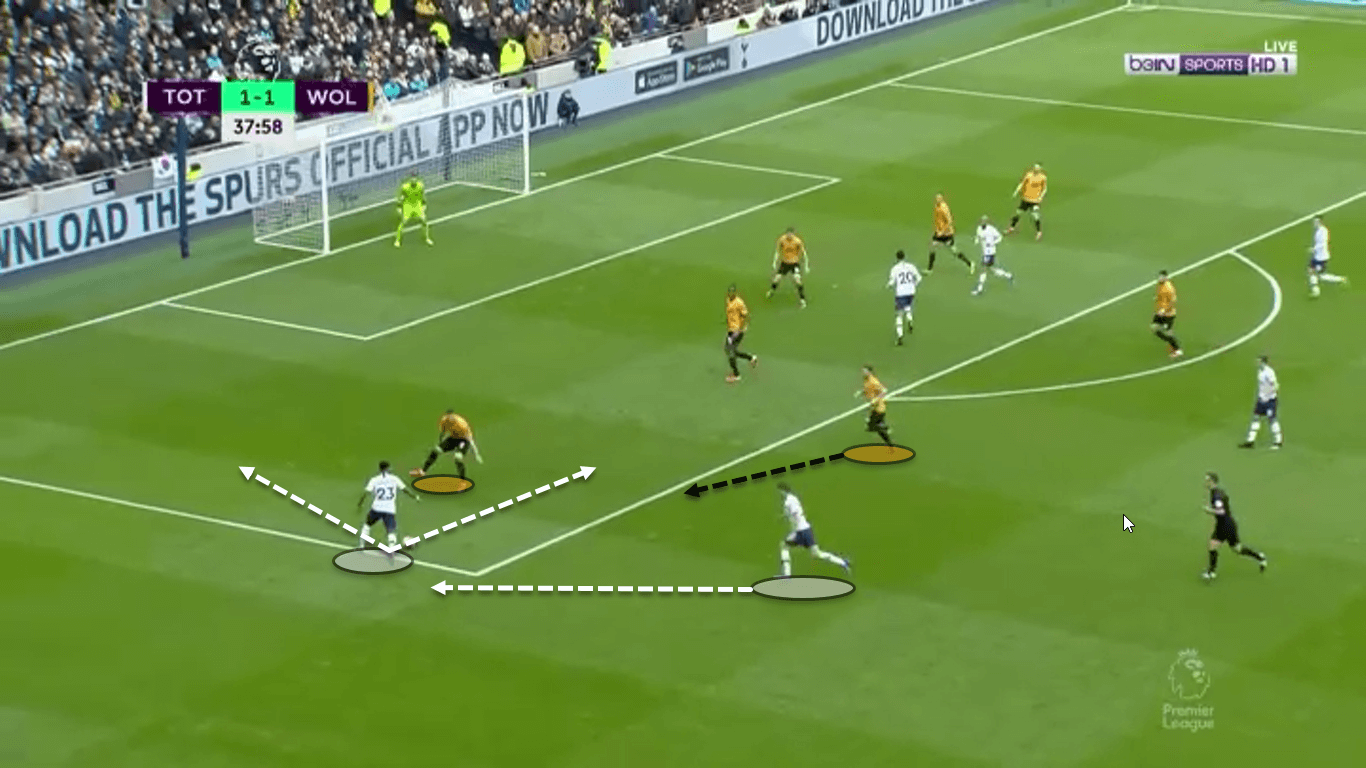
How Wolves attack
This tactical analysis has looked at how Nuno has set his team up defensively. Because of this, it enables Wolves to counter-attack efficiently, 37.43% of which lead to a shot on goal, making it no surprise that Jota, Jiménez and Traoré have 34 goals between them in all competitions this season. The way they counter-attack also means that they are still defensively solid as only 24.69% of their opponent’s counterattacks lead to a shot on goal.
The reason they can be so effective is the variation on their counter-attacks. When using a 3-5-2 Jota and Jiménez can combine centrally. Looking at their third goal against Norwich, Wolves have been able to win the ball back in the middle of the pitch, because of their advanced position Dendoncker is able to quickly get the ball to Jiménez who can break with Jota. What the two are then good at is reading each other runs making it difficult for the opponents to track. In this example, they are running diagonally across each other dragging the defender with them, this creates the space for Jiménez to play the ball through to Jota, who hits the post with the ball falling kindly back to Jiménez who scores.
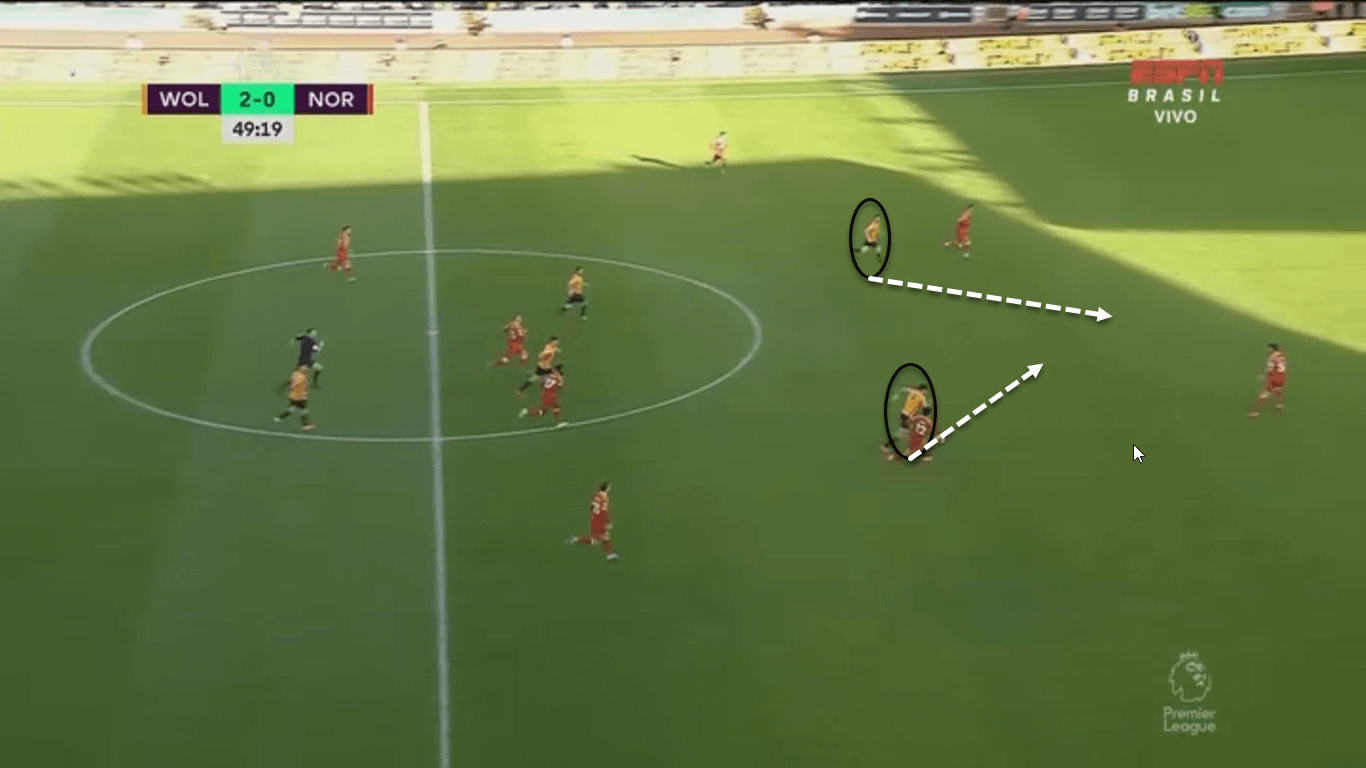
What the 3-4-3 provides is an advantage on the wings. To target the space in behind the winger will come short taking the full-back with him and then play a one-two with the wing-back to get in behind. This is what happens on this occasion as Jota comes short and is able to play the one-two to get in behind. Because of the space, Jota has worked he has time to pick out a cross leading to Wolves equaliser.
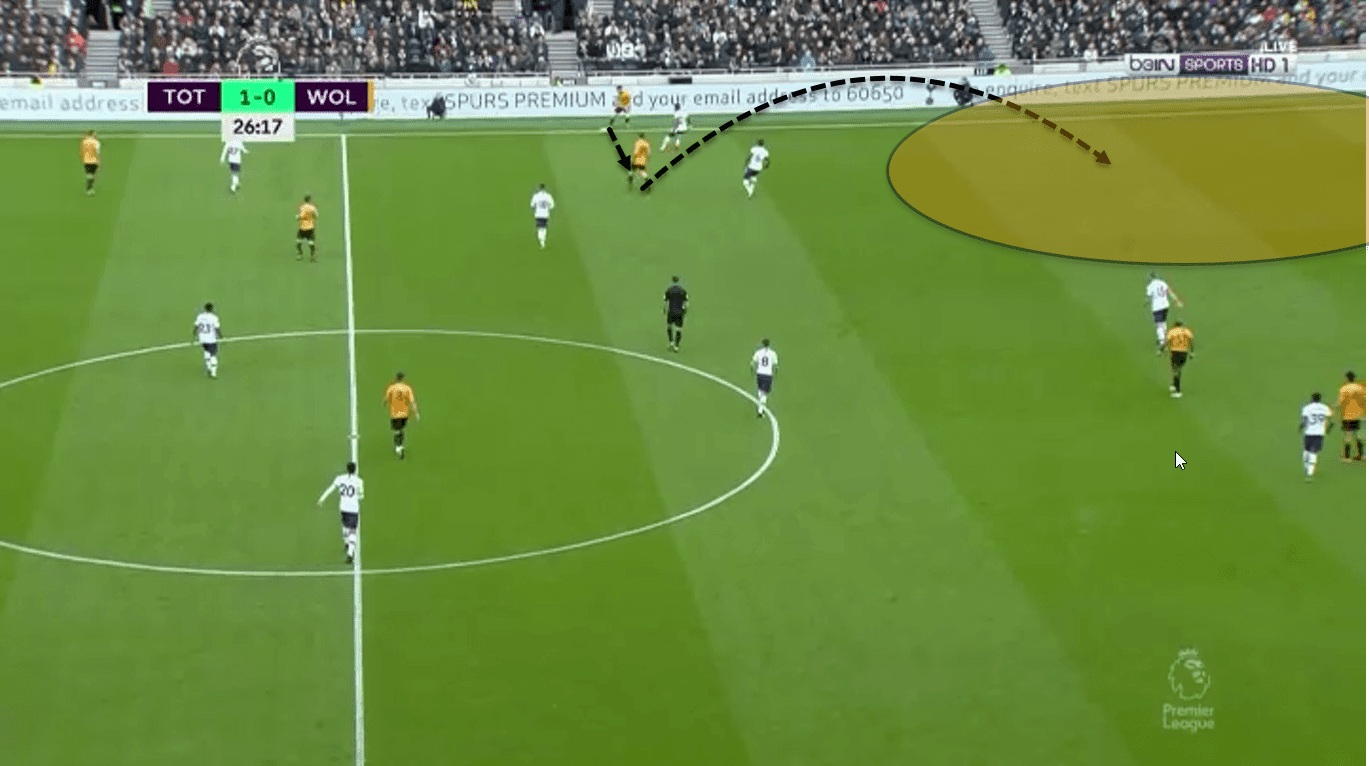
Counter-attacking variations
So far this tactical analysis has illustrated how Wolves can switch between a 3-5-2 and a 3-4-3. This is also reflected in their attacking style as at times both will merge into each other. This happens as in the 3-5-2 as Moutinho will break with the front two effectively making the formation a narrow 3-4-1-2. This is also what happens with the 3-4-3 as often one of the wide players will come short for the ball or drive out of defence with the ball. This is so Wolves try to break as a three to make it harder for teams to defend.
This is what happens for their winner against Tottenham Hotspur. For this goal, Jota picks the ball midway in his half and is able to drive deep into Spurs half and find the run of Jiménez, the striker is then calmly able to sit the defender down and score the winner. What this goal demonstrates is how quickly Wolves can transition from defence to attack without committing many players forward; it can clearly work as their average expected goals is 1.47 whereas their opponents is 1.07.
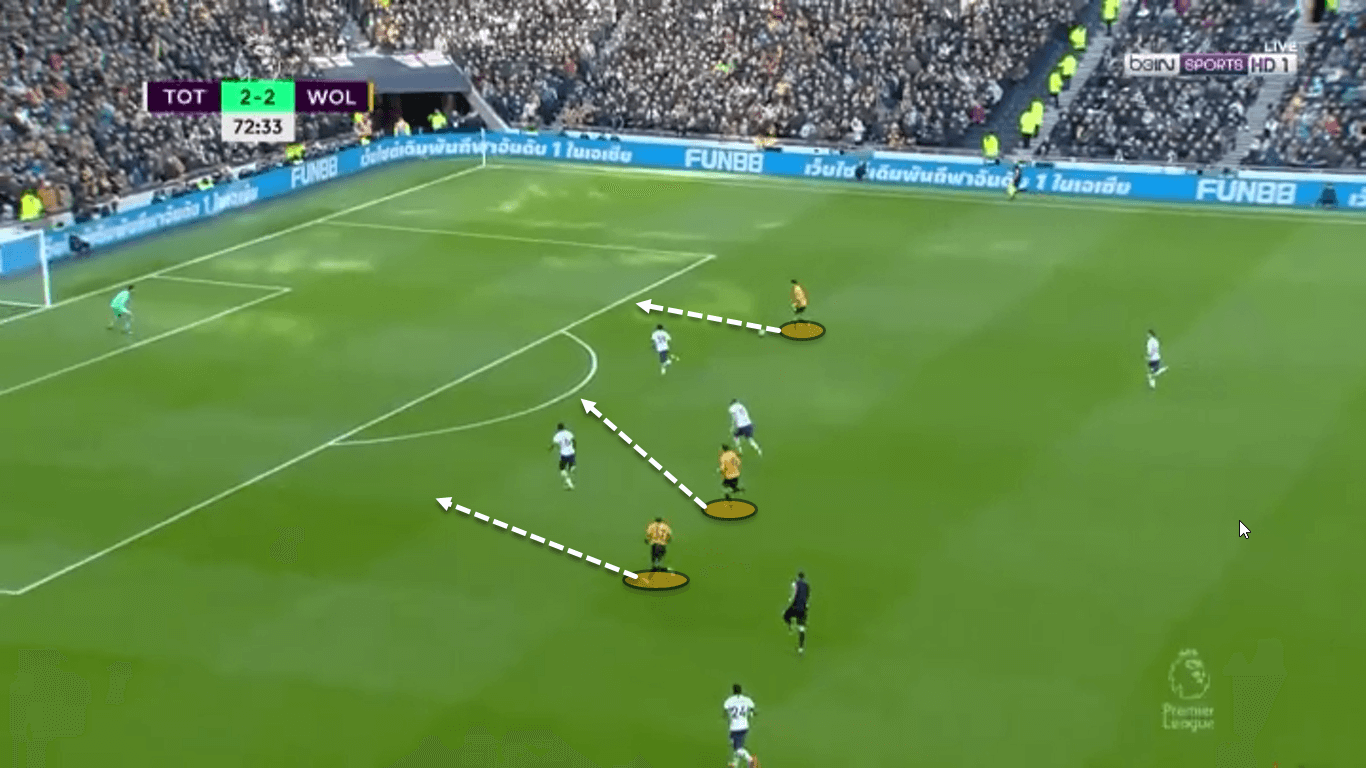
How Wolves move through the phases
Nuno’s attacking mentality is to get the ball forward and wide as quickly as possible. This starts with the centre-backs. Their positioning is interesting as Neves will drop back in between Boly and Saïss, while Conor Coady will drop even further back. This is to draw their opponents onto them meaning there is more space in the middle and wide. It also gives Coady more time to find a pass to the wing-backs. This is because Wolves like to build attacks by playing a pass out wide so they can bounce the ball back in, often using the same combination of players that would form the three-man press when defending. The type of ball Coady is looking for is also the same regardless of if Wolves are playing a 3-4-3 or a 3-5-2.
Looking at the example below it illustrates how Coady’s deep position has drawn out three Brighton players. This enables him to switch the ball out to Doherty who quickly has Jiménez and Dendoncker as passing options, due to their position on the pitch it often means that these players will also press together if they lose the ball it, therefore, demonstrates that because of Wolves shape they are able to use this press in both an offensive and defensive way.
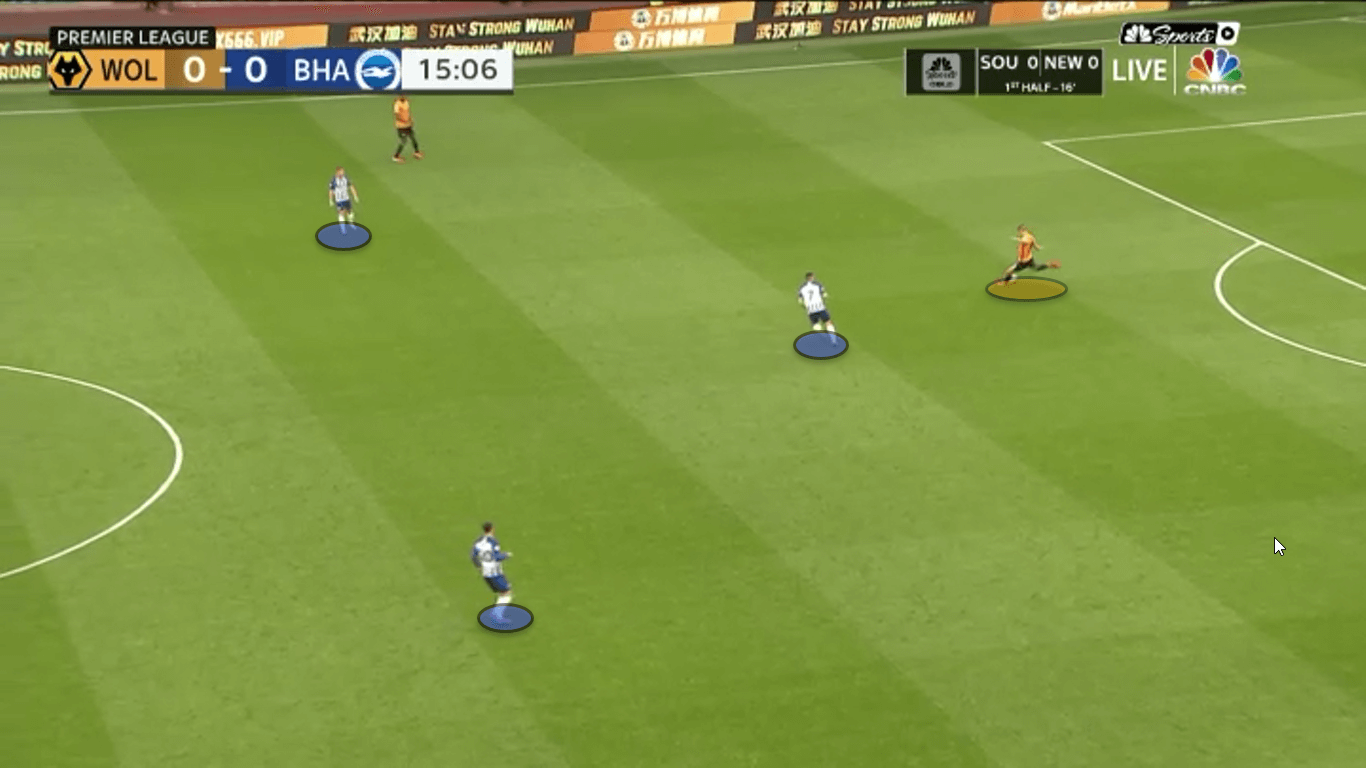
Rúben Neves pivotal position
If for Coady the pass out wide is not on then the next phase is to go through Neves, and even if Coady does find the wing-back Wolves will often look to switch the ball and that is through Neves. The point is regardless of whether Wolves are playing a 3-4-3 or 3-5-2 formation Neves controls the game for them. The young midfielder is pivotal to Wolves and does an excellent job at it. He may grab the headlines for his wonder strikes but his distribution is the key to Wolves. Part of the reason he is effective is his positional awareness. Looking at his territorial coverage as a defensive midfielder it shows that he spends the majority of his time in a deep position and around the middle of the pitch, this is so he can dictate the game.
When on the ball Neves will only take a couple of touches on the ball in order to move the ball on as quickly as possible, he does this well as he completes 89.5% of his forward passes and 85.1% of his long passes. He is also comfortable doing this under pressure as he completes 92% of his passes in the oppositions half. What this means for Wolves is he can get the ball to players in dangerous areas quickly and accurately. What the example shows is that Leicester have got three players to the left to make it difficult for the Wolves players to get around the side. This is where Neves comes in as he will collect the ball in this area and switch it to Traoré who is one vs one against Ben Chilwell. As a result, this switch of play creates a more threating scenario for Wolves than trying to force the play on the left side.
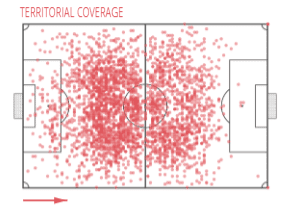
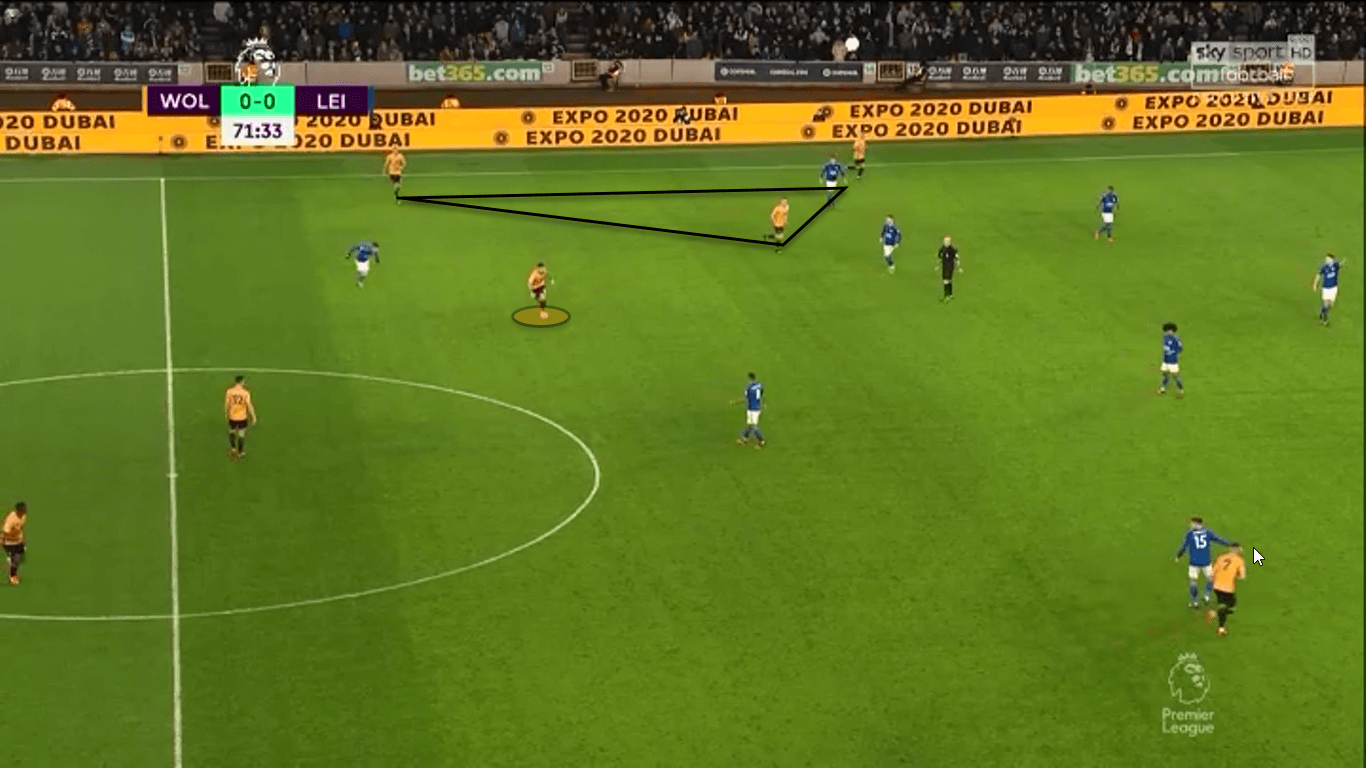
Too many draws may hold Wolves back
As mentioned earlier Wolves have had 13 draws this season. This has been a problem for Wolves as in 9 of these games Wolves have had a higher expected goal than their opponent, this indicates that they have looked the more threating team in these games, however, this is often because of the positions they find themselves in. As this tactical analysis has mentioned Wolves like to break with three players regardless of the formation. This is effective because they can do this quickly and teams cannot get numbers back, however against a team that does not commit players forward it often means that Wolves players are outnumbered.
The example below illustrates the problem Wolves have had as they have been able to get three players forward, however as Brighton have numbers back they are able to surround Jota meaning he has a lot to do. In this particular example Jota is able to make it into the box but as he only has Jiménez in the box and Jota is surrounded, they lose the ball. As Wolves are outnumbered in the final third in some games they have been unable to open up their opponents.
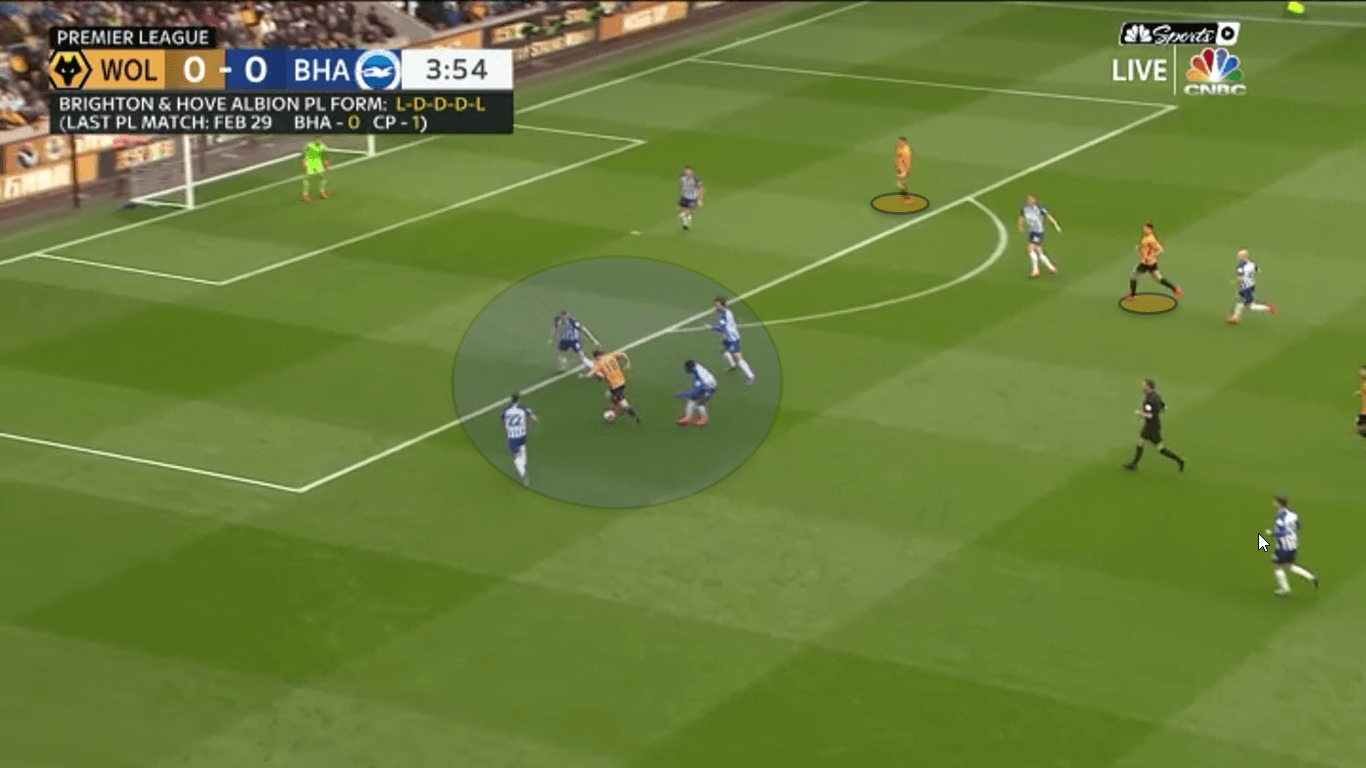
Conclusion
This tactical analysis has looked at Nuno Espírito Santo Wolves. The analysis broke down how Wolves can effectively defend and attack for different opponents with a slight adjustment to their formation. This flexibility has made them a dangerous team this season and if the season continues they are a real contender for a Champions League spot. With Chelsea, Sheffield United and Arsenal to still potentially play it would not be a surprise if Nuno’s side finished fourth or fifth.

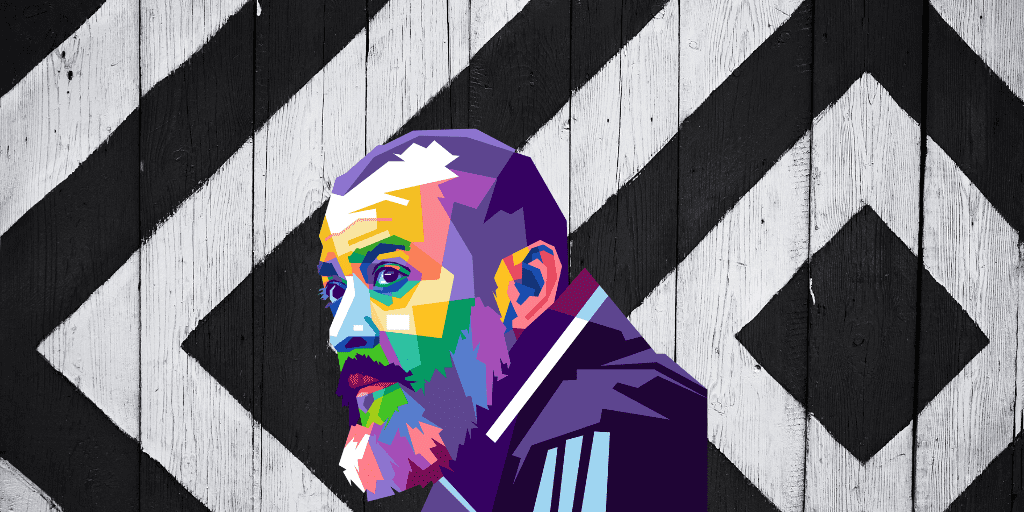




Comments